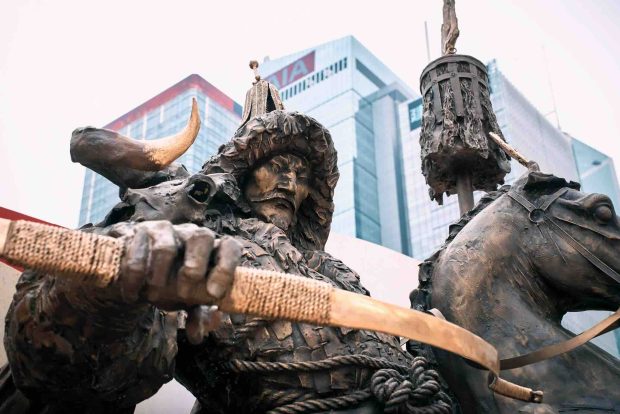Learn the rise and fall of the Edo Samurais by hopping onto Tobu Railway as it travels through four Edo prefectures. Along the way, see the World Heritage Nikko Toshogu Shrine where the first Edo shogun period was enshrined; Ouchi-juku, a post town where samurais are preserved; and Tsurugajo Castle, the scene of a fierce civil war which ended the Edo Period.
Trip into History – Places of Interest
The trip into history dubbed the “Samurai Route” starts from Senso-ji Temple in Asakusa. Established in the Edo Period, it is known to be one of the oldest shopping centres in Japan. Shops selling typical Japanese souvenirs and Japanese confectioneries are abound in the Nakamise street leading from the Kaminarion gate with the large lantern to the main temple.
Tobu Rail’s new limited express train, Revaty which began service on April 21, provides Wi-Fi and power outlets for each seat and will pass by the TOKYO SKYTREE which is the highest tower in the world.
At Tobu Nikko Station, visitors are advised to purchase a “World Heritage Tour Ticket” at the Tobu Nikko Station Tourist Centre. From here, visitors can take the “World Heritage Bus” and go around the World Heritage Shrines and Temples of Nikko.
“Shrines and Temples of Nikko” include Nikko Toshogu Shrine which is one of the World Heritage sites that represent Japan. The shrine enshrines Tokugawa Ieyasu, the first shogun of the Edo Shogunate and the site is breathtaking. Repair works on the shrine had been ongoing for four years and completed in March this year. Visitors will be able to see the Yomeimon Gate and pillars of Nikko Toshogu Shrine are decorated with many intricate carvings. The popular image for visitors is the “three monkeys’ which represent “see, hear or speak no evil”.
In addition to the World Heritage Bus, Tobu Bus also offers bus services in the Okunikko area where visitors can enjoy the nature of Nikko. The bus will bring visitors through the Irohazaka Route and its sharp curves to reach the Ryuzu Falls where Togoku-mitsuba-tsutsuji (Rhododendron wadanum) is in full bloom from late May to early June.
Along the way, the bus will pass through Lake Chuzenji, Mt. Nantai and a hiking course that travels through a large marsh where visitors can enjoy nature at its best.
You can stay at the nostalgic Nikko Kanaya Hotel which is the oldest resort hotel in Japan. The ambience of the hotel makes visitors feel as though they are in the Edo era.
Tobu Railway will take visitors from Tobu Nikko Station to Yunokami-Onsen Station. From there, head for Ouchi-juku which is one of the post towns where townscape of the Edo Period is preserved. In the Edo Period, this place served as a passage connecting Aizu and Nikko and a post town for daimyo lords (powerful samurai that directly served the shogun in the Edo Period). You can see the thatched houses (more than 30 of them) that lined along the street and Japanese landscape from the Edo era.
From Yunokami-Onsen Station, head to Aizu-Wakamatsu Station and then to Tsurugajo Castle (also known as Aizu-Wakamatsu Castle). This Castle is where the Boshin War was fought between the new government forces who tried to create a new country and the former Shogunate forces who tried to protect the Edo Shogunate. The new government forces won the war and this led to the modernization of Japan. However, loyalists of Byakkotai who fought on the former Shogunate side and their tragic story is well-known till today.
Sample Traditional Foods of Nikko
Nikko offers traditional cuisine that represents Japan. The soba noodles are made from the pure water flowing from the foothills of the mountains of Nikko and yuba (bean-curd skin) which is a traditional food of Nikko made by boiling soy milk made from soy beans. At “Nikko Yuba-maki ZEN” which is located near the Nikko Toshogu Shrine, enjoy the original “Nikko yuba-maki set” which uses yuba and costs ¥2,160.
At Ouchi-juku, there are restaurants and souvenir shops along the thatched houses. Visitors should try the negi soba which you eat using green onion instead of chopsticks.
ねぎそば( ̄∇ ̄) 意地でもネギで食べる( ̄^ ̄) #福島県 #大内宿 #本家玉屋 #ねぎそば
A post shared by Naoki Kawamura (@na0kism) on
Tsurugajo Kaikan which is located north of Tsurugajo Castle, sells souvenirs and local sake of Aizu. Aizu which is also where rice is produced, offers various kinds of local sake. The sake is delicate in taste, slightly sweet and smooth in texture which is popular among women. Visitors can buy the unique steamed millet dumpling made with millet and sticky rice (¥97 for 1 piece) at Koike Kashiho which sells Japanese confectioneries inside Tsurugajo Kaikan.
A shop named Nagatoya (established in 1848 during the Edo Period), sells Kagunokinomi which is made by wrapping an entire Japanese walnut produced in Aizu with high-quality bean curd and covering the surface with brown sugar. This was served at the Ise-Shima Summit in 2016 when leaders of G7 countries gathered and it wa also chosen in the “Ultimate World-Class Souvenir” contest.
Another shop named Taroan, sells Kitakata ramen pudding (¥432 for 1 cup) which looks like ramen, but it is a pudding cake. The soup is made with tea mousse, noodles are made with marron cream and roast pork is made with chocolate. It is a cake that is irresistible. The shop is located at the East Exit of Aizu-Wakamatsu Station.
We hope you find our itinerary via Tobu Railway useful. Are you ready to learn the rise & fall of the Edo Samurais by hopping onto Tobu Railway as it travels through these four gorgeous Edo prefectures.?








